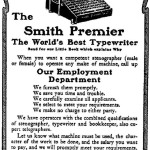Are you clear what business you are in? For the brothers Lyman, Wilbert, Monroe and Hurlburt Smith, they knew they were in the typewriter business. In 1886, they found the Smith Premier Typewriter Company who later became Smith Corona. Their device had both upper and lower case letters and their like to boast that they had a key for every character. Things were simpler in 1886.
I learned to type on an electric Smith Corona at Jonathan Dayton Region High School in 1969. At the time, I thought it was a great idea to learn to type since the class was about 85% girls. I also thought typing for myself might somehow come in handy when I eventually went to college.
Smith Corona, like Kodak and other businesses lost their way in the world. They were so married to a technology, that they forgot the real business they were in wasn’t typewriters but communication. From the manual typewriters to the electric versions, Smith Corona was letter-perfect growing by leaps and bounds until those pesky word processors showed up on the scene. And the link from a word processor to a laptop was the death knell for their business.
Not My Type
Smith Corona should have work to understand the real job that their product solved. By partnering with leading technology firms who were taking advantage of the silicon chip, they could have continued heading toward the future. Instead of exploring microprocessors, Smith Corona kept improving the typewriter. In Kodak’s case, they kept improving their work on emulsion film. Clearly both companies were unable to cross the chasm to the future as they stayed stuck in the past.
What are the lessons for growing businesses today?
DAILY REMINDER: Keep some physical examples of old technology in your office to remind you every day that one day, your products will also go on that History Museum of Dead Products. An old Smith Corona is a beautiful daily reminder but a box of Kodachrome will also  work. Keep a late 1980’s cell phone around. How about a transistor radio? That frequent glimpse of the past should poke you and your team to ask some difficult questions.
work. Keep a late 1980’s cell phone around. How about a transistor radio? That frequent glimpse of the past should poke you and your team to ask some difficult questions.
LOVE YOUR SOLUTION NOT YOUR PRODUCT: Don’t fall in love with how you do something but ask how consumers will solve that problem into the future. Imagine how customers tomorrow will have different needs as you watch new trends taking hold in the economy. People are eating less gluten. We rent or lease more often and new businesses make it easier for us to avoid a purchase. We are in a connection economy and a shareable economy. Is your solution going to endure through those changes?
SCENARIOS MATTER: Place some calculated bets on scenarios that may develop. Experiment a bit. If the future isn’t clear, have a few horses in the race. When you explore what might happen without worrying about being exactly right, patterns emerge and you pay attention to what is happening outside of your companies walls.
COMPETE AGAINST YOURSELF: Set up a small skunks-work team that finds your vulnerabilities before the competition does that job and upends your business. Or consider starting a challenger company to your own technology whose mission is to get to the future faster than you may be able to do within the organizational structure. Or buy that annoying challenging company that is eating away a little bit at a time at your pricing power because of their ‘newfangled’ gadget.
LESSONS LEARNED: Learn from other businesses who have successfully navigated through similar challenges. Traditional newspapers who figured out how to simultaneously be online at least have a fighting chance to straddle the two worlds while the market getting sorted out. Understand how brands have survived by adapting and see how you can model yourself after the survivors. Can your company shed its skin for the coming decade and reinvent itself? If not, you may be headed the way of the typewriter.
What Business Are You In?
I’m typing – well, writing this blog post from an airplane traveling at 600 miles an hour at 30,000 feet. The words are captured on a little chip that is as thin as a strand of hair but I see the words on this illuminated screen. I’m not plugged into any power source but run on a battery that will last six hours. I’m connected to the Internet wirelessly and will post this while in flight to a server in the clouds. Talk about cloud technology.
Imagine what Lyman, Wilbert, Monroe and Hurlburt Smith would think – and what would they write on their typewriter?
Interested in growing your business? Do you understand what business you are in? I can help you increase profitable revenue with marketing insights. To learn more, click this link.




